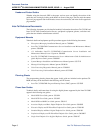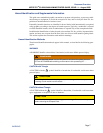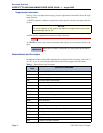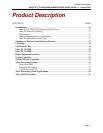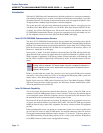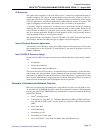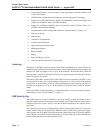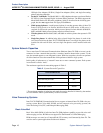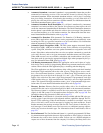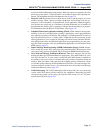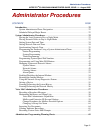
Product Description
INTER-TEL
®
CS-5200/5400 ADMINISTRATOR GUIDE, ISSUE 1.1 – August 2005
Page 14 Licensing
• CompactFlash memory card for storing system applications, customer database, and
voice mail messages
• USB flash drive (thumb drive) for backing up voice mail prompts and messages
• Support for IP, SIP, Multi-Protocol, Wireless IP, Multimedia Touch Screen, digital, and
single line hard phones, and for one PDA soft phone
• Support for nonphone endpoints such as IP gateway trunks, IP SLAs, SLAs, fax
machines, and answering machines
• Programmable Call Processing features (Refer to “System Features” on page 111)
• Directory Look-Up
• Hunt Groups
• Automatic Call Distribution
• Uniform Call Distribution
• Open Architecture Interface (OAI)
• Multilingual Support
• Music-On-Hold
• Paging
• Power Fail Bypass circuitry
• Wide Area Network (WAN) Fail Survivability
Licensing
The Inter-Tel CS-5200 is the basic system. In the default configuration, it comes with five IP
endpoint licenses and three IP networking resources. With required hardware and licensing, the
Inter-Tel CS-5200 can support a mix of up to 28 IP endpoints, IP network trunks, and/or IP
gateway trunks. Additional IP endpoint licenses are required before more than five IP end-
points will operate on a system.
The Inter-Tel CS-5400 is an Inter-Tel CS-5200 with a Processor Expansion Card (PEC-1) and
licensing added to the system. In the default configuration, it comes with five IP endpoint
licenses and six IP networking resources. With required hardware and licensing, the Inter-Tel
CS-5400 can support a mix of up to 116 IP endpoints, IP network trunks, and/or IP gateway
trunks.
Each of the DEIs is licensed separately, as are premium features. For lists of standard and pre-
mium features refer to “System Features” on page 111.
USB Security Key
The USB security key uniquely identifies a system by storing an Inter-Tel Master License.
Only the specific software license that has been digitally signed with the Master License data is
allowed to control the system. The key stores the essential components of the software licens-
ing scheme.
The security key also ensures licensing integrity. When a system detects removal of its key, the
system disables audio for subsequent calls. When the audio is disabled, the system posts appli-
cable alarms to the LCD panel on the front of the unit chassis and to the LCD on the Adminis-
trator endpoint. Alarm #122 indicates that the key is missing, while Alarm #125 identifies the
number of minutes before the system initiates a reset.



